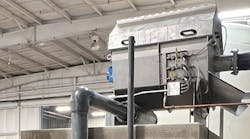By Patrick Crow, Washington Correspondent
Infrastructure financing was the major topic in the Washington, DC, water community as the new Congress got underway. Foremost was a January 18 Environmental Protection Agency (EPA) memo. Nancy Stoner, acting assistant administrator for water, and Cynthia Giles, assistant administrator for enforcement and compliance assurance, sent EPA regional offices a guidance on how a community's financial capability should be considered when developing schedules for projects required to meet Clean Water Act (CWA) obligations.
Over the past few years local governments have complained about the high cost of complying with CWA requirements and enforcement actions, particularly in regard to wet weather overflows and stormwater management.
The U.S. Conference of Mayors, the National League of Cities and the National Association of Counties applauded more lenient EPA clarification.
The National Association of Clean Water Agencies (NACWA) said, "Communities across the United States are struggling to meet their CWA obligations due to pressing economic issues." It further said EPA's implementation and enforcement methods had placed "unprecedented costs on communities and ratepayers, sometimes without regard to other less expensive alternative approaches that may be more effective."
NACWA said it expects the latest EPA directive to continue to evolve. It said the missive stopped short of being a wholesale rework of the agency's 1997 financial capability guidance, which the association maintains is overdue for a "comprehensive revision."
The EPA memo came on the heels of an American Society of Civil Engineers report that predicted an $84 billion shortfall in theIn a presentation to the annual Conference of Mayors, the Water Environment Federation (WEF) also stressed the jobs/water infrastructure connection.
"There has never been a more critical time to reinvest in our essential water infrastructure," WEF Executive Director Jeff Eger told the mayors. The association has launched a "Water for Jobs" campaign that plans to hold a national water infrastructure summit in April.
In the House of Representatives, the Water Resources and Environment Subcommittee pledged to "pursue and examine finding innovative ways to finance new and replacement of old water infrastructure projects." That could add impetus to the Water Infrastructure Finance and Innovation Act that Subcommittee Chairman Bob Gibbs (R-Ohio) is expected to introduce (see WW, January 2013).
Finally, WEF, NACWA, and the Water Environment Research Foundation launched their "Utility of the Future" initiative predicated on infrastructure change.
The groups said traditional, publicly-owned utilities have mastered their core wastewater treatment function and now are redefining themselves as resource recovery agencies and community enterprises.
"Today's utilities are reclaiming and reusing water, extracting and finding commercial uses for nutrients and other products, becoming more efficient energy users and renewable energy producers, and using green infrastructure to manage stormwater and to improve the quality of life," Eger said.
The water groups drafted a "Blueprint for Action" that examines barriers, suggests incentives for innovation, and outlines actions that could further change the dynamics of the industry. The actions include legal changes to sanction watershed-based solutions to the major water quality challenges; revisions to encourage water reuse and water conservation where feasible; provisions to enable utilities to fully recover waste heat and energy and to produce renewable energy; and discusses reforms in disparate federal financial support programs.
The blueprint urges Congress to craft a "21st Century Watershed Act" that builds on CWA's achievements by giving water companies the means to transition to more proactive "utilities of the future." The groups also will encourage the creation of a congressional water caucus this session to facilitate that legislation.
A caucus is an informal organization for congressmen with common interests. There were more than 300 caucuses in the last Congress, many of them on unusual topics (e.g., Serbia, submarines, shellfish, and soils). But there's not been a caucus on mainstream water issues for some time, if ever.
Elizabeth Striano, NACWA's director of social media and communications, said, "Our intent is to form [a caucus] focused on the resource recovery aspects of the wastewater/water treatment systems. The focus will be on innovation and technology in line with the Utility of the Future Blueprint."
WaterWorld Articles Archives



